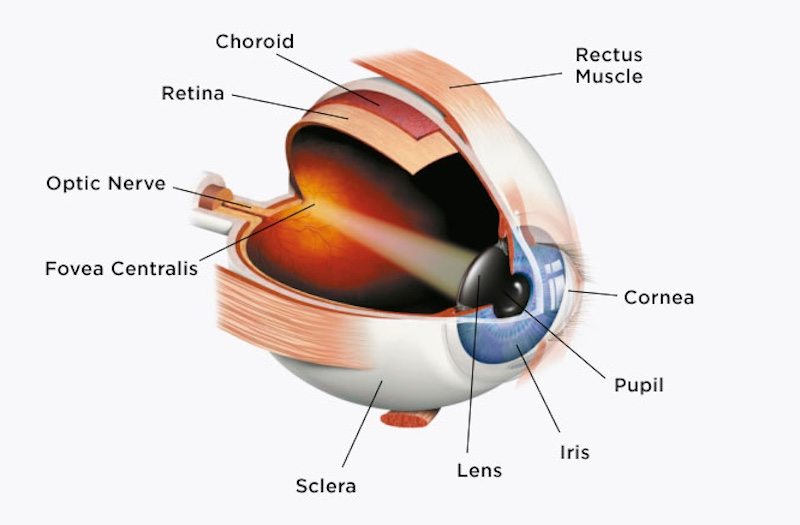Losing your vision can be one of the most difficult things to experience. However, thanks to modern medicine, it is now possible to restore vision through a corneal transplant. The cornea is the clear, dome-shaped surface that covers the front of the eye. It allows light to enter the eye, which is essential for vision. A corneal transplant involves replacing a damaged or diseased cornea with a healthy one from a donor. This procedure can be life-changing for those who have lost their vision due to injury or disease. In this post, we will follow the journey of a corneal transplant, from the diagnosis of the problem to the recovery process. We will also explore the benefits and risks of this procedure and provide helpful tips on how to care for a newly transplanted cornea. So, let’s dive in and learn more about this incredible procedure and how it can help restore our sight.
-
Introduction: Understanding corneal transplantation and its significance
Introduction: Understanding corneal transplantation and its significance
Corneal transplantation, also known as corneal grafting or keratoplasty, is a surgical procedure that aims to restore vision and improve the quality of life for individuals with corneal disorders or damage. The cornea, the transparent outer layer of the eye, plays a crucial role in focusing light onto the retina, allowing us to see clearly.
Unfortunately, various factors such as disease, injury, or hereditary conditions can impair the cornea, leading to vision impairment or even blindness. In such cases, corneal transplantation emerges as a remarkable solution, offering new hope and a chance to regain visual acuity.
The procedure involves replacing the damaged or diseased cornea with a healthy cornea from a deceased donor. This remarkable transplantation technique has been transforming lives for decades, enabling individuals to see clearly and experience the world in all its splendor once again.
The significance of corneal transplantation extends far beyond the restoration of vision. It extends to the restoration of independence, the ability to engage in daily activities with ease, and the restoration of confidence and self-esteem. Imagine being able to witness the smiles of loved ones, appreciate the beauty of nature, or pursue passions and dreams with renewed clarity.
It’s important to understand that corneal transplantation is a complex and delicate procedure that requires skilled surgeons, meticulous pre-operative evaluation, and post-operative care. However, advancements in medical technology and surgical techniques have greatly enhanced the success rates and outcomes of corneal transplantation, making it a viable option for many individuals seeking visual rehabilitation.
Throughout this blog series, we will delve deeper into the journey of a corneal transplant, exploring various aspects such as the pre-transplant evaluation process, the surgery itself, the recovery period, and the remarkable stories of individuals whose lives have been transformed by this procedure.
Join us as we embark on this enlightening journey, shedding light on the transformative power of corneal transplantation and the incredible impact it has on the lives of those who undergo this life-changing procedure.
-
The story behind needing a corneal transplant
Every corneal transplant has a unique and personal story behind it. The need for a corneal transplant can arise from a variety of reasons, each with its own set of challenges and emotions.
For some individuals, a corneal transplant becomes necessary due to a congenital condition that affects their vision from birth. These individuals have had to navigate a world of blurry shapes and limited visual clarity, often relying on glasses or contact lenses to improve their vision. The prospect of a corneal transplant brings hope and the promise of seeing the world with newfound clarity.
Others may require a corneal transplant as a result of an injury or trauma to the eye. Whether it be a sports-related accident, a workplace mishap, or a sudden and unforeseen event, the consequences can be devastating. The loss of vision can be traumatic, impacting not only one’s physical abilities but also their emotional well-being. In these cases, a corneal transplant represents a chance to regain independence and resume a normal life.
There are also individuals who develop corneal diseases or conditions over time, such as keratoconus or Fuchs’ dystrophy. These conditions progressively deteriorate the cornea, causing vision impairment that cannot be corrected with glasses or contact lenses alone. For them, a corneal transplant becomes a lifeline, offering the possibility of clear vision and an improved quality of life.
Regardless of the underlying reason, the journey toward a corneal transplant is often filled with uncertainty, anxiety, and hope. It involves consultations with ophthalmologists, extensive medical evaluations, and waiting lists for a suitable donor cornea. Each step brings a mix of emotions, from anticipation and excitement to fear and apprehension.
However, the moment when a compatible cornea becomes available and the transplant surgery takes place marks a turning point in the journey. It is a moment of immense gratitude for the selfless act of the donor and their family, who have given the gift of sight to another person. It is also a moment of hope, as the recipient begins the healing process and eagerly awaits the transformation that will follow.
The story behind needing a corneal transplant is a deeply personal one, filled with triumphs, challenges, and the resilience of the human spirit. It is a story of individuals who refuse to let their vision loss define them and who bravely embark on a path toward seeing clearly again.
-
Preparing for the corneal transplant surgery
Preparing for a corneal transplant surgery is a crucial step in the journey towards seeing clearly again. This process involves several important aspects that need to be carefully considered and planned for.
First and foremost, it is essential to find a skilled and experienced ophthalmologist who specializes in corneal transplants. This expert will guide you through the entire process, from initial consultations to post-operative care. They will assess your specific case, evaluate the condition of your cornea, and determine if a transplant is the most suitable option for you.
Before the surgery, your ophthalmologist will thoroughly explain the procedure, addressing any concerns or questions you may have. It is essential to have a clear understanding of what to expect during and after the surgery, including the potential risks and complications.
In some cases, certain medications or eye drops may be prescribed to prepare your eye for the surgery. These medications may help to reduce any inflammation, control eye pressure, or prevent infections. It is important to follow your doctor’s instructions carefully and inform them of any allergies or adverse reactions you may have experienced in the past.
Additionally, it is crucial to arrange for transportation to and from the surgical facility on the day of the transplant. Since you may experience temporary vision impairment or discomfort immediately after the surgery, having someone accompany you will ensure your safety and peace of mind.
Preparing yourself mentally and emotionally is also an essential part of the process. It is natural to have fears and anxieties about undergoing surgery, but it is important to focus on the potential positive outcome and the improvement it will bring to your vision. Surrounding yourself with a supportive network of friends and family can provide the encouragement and reassurance needed during this time.
Overall, preparing for a corneal transplant surgery involves careful planning, finding the right healthcare professional, understanding the procedure, and ensuring personal support. By taking these necessary steps, you can approach the surgery with confidence, knowing that you are doing everything in your power to regain clear vision and enhance your quality of life.
-
The process of finding a suitable cornea donor
Finding a suitable cornea donor is a critical step in the journey of a corneal transplant. It involves a meticulous process that ensures the best possible match for the recipient. The availability of cornea donors is essential, as it determines the success and outcome of the transplant.
The first step in finding a suitable cornea donor is through organ and tissue donation programs. These programs facilitate the collection, preservation, and allocation of corneas from deceased donors. It is crucial for individuals to register as organ donors during their lifetime to increase the chances of finding suitable donors when the need arises.
Once a potential cornea donor becomes available, a thorough evaluation is conducted to assess the suitability of the cornea for transplantation. The evaluation includes checking the medical history of the donor, conducting various tests to determine the health and viability of the cornea, and ensuring compatibility with the recipient.
Factors such as the age, health condition, and cause of death of the donor are taken into consideration during the evaluation process. The cornea must be free from any infections, diseases, or damage that may affect its viability for transplantation. Additionally, compatibility in terms of blood type and tissue match is essential to minimize the risk of rejection by the recipient’s immune system.
Specialized eye banks play a crucial role in the process of finding suitable cornea donors. These eye banks carefully screen and select corneas from donors, ensuring that only the highest quality corneas are used for transplantation. They follow strict protocols and guidelines to maintain the integrity and safety of the donated corneas.
The process of finding a suitable cornea donor requires coordination and collaboration between various healthcare professionals, including ophthalmologists, transplant coordinators, and eye bank personnel. Their expertise and dedication contribute to the successful identification and allocation of corneas for those in need.
Ultimately, the process of finding a suitable cornea donor is a vital step in restoring vision and improving the quality of life for individuals in need of a corneal transplant. It is a testament to the generosity and selflessness of organ donors and the tireless efforts of healthcare professionals working towards the common goal of helping others see clearly again.
-
The surgical procedure and what to expect
Undergoing a corneal transplant can be a life-changing experience, restoring clarity and vision to those who have struggled with corneal conditions. The surgical procedure itself is a meticulously performed process that requires expertise and precision.
Firstly, it’s important to note that corneal transplant surgery is typically performed under local anesthesia. You may be given a mild sedative to help you relax during the procedure, but you will remain awake and aware. The surgeon will use a microscope and specialized instruments to carefully remove the damaged or diseased cornea.
Next, the healthy donor cornea will be prepared for transplantation. The cornea is obtained from a deceased donor who has generously donated their corneas for transplantation. These corneas are thoroughly screened and matched to ensure compatibility with the recipient’s eye.
Once the donor cornea is ready, the surgeon will carefully stitch it onto the recipient’s eye using ultra-fine sutures. These sutures are designed to hold the new cornea securely in place while it heals. Depending on the specific case, the surgeon may also use additional techniques such as tissue glue or a temporary amniotic membrane to aid in the healing process.
After the surgery, you can expect to experience some discomfort and blurred vision. Your eye may be patched for a short period of time to protect it during the initial healing phase. It is normal to have some redness, tearing, and sensitivity to light in the days following the procedure.
Recovery from a corneal transplant can take several weeks to months, and it is important to follow post-operative instructions provided by your surgeon. This may include using prescribed eye drops, avoiding activities that could strain the eye, and attending regular follow-up appointments to monitor the healing progress.
While each individual’s experience may vary, the ultimate goal of corneal transplant surgery is to improve vision and restore quality of life. With time and proper care, many individuals find that their vision gradually improves, allowing them to see clearly again and engage in activities that were once challenging or impossible.
It is important to remember that every corneal transplant journey is unique, and it is essential to consult with a qualified eye care professional to understand the specific details and expectations of your own procedure.
-
Post-transplant recovery and follow-up care
After undergoing a corneal transplant, the road to clear vision is not yet complete. Post-transplant recovery and follow-up care play a vital role in ensuring the success of the procedure and the long-term health of the transplanted cornea.
During the initial days following the transplant, it is normal to experience some discomfort, blurred vision, and sensitivity to light. Your ophthalmologist will prescribe medications, such as antibiotics and anti-inflammatory eye drops, to prevent infection and reduce inflammation. These medications are crucial in the early stages of recovery and should be used as directed.
Regular follow-up visits with your ophthalmologist are essential to monitor the progress of your recovery and assess the functionality of the transplanted cornea. These visits will initially be frequent, typically occurring within the first few weeks after the surgery. During these appointments, your doctor will examine the cornea, measure visual acuity, and ensure that the graft is healing properly.
As the recovery progresses, the frequency of follow-up visits will gradually decrease. However, it is important to attend all scheduled appointments to address any potential issues that may arise. Your ophthalmologist will closely monitor your progress and make necessary adjustments to your medications or treatment plan.
In addition to follow-up visits, you will also be advised to take certain precautions during the recovery period. Protecting your eyes from potential hazards, such as dust, wind, or harsh sunlight, is crucial to prevent any complications. Wearing sunglasses and using protective eyewear when necessary can aid in maintaining the integrity of the transplanted cornea.
It is important to note that the recovery process can vary from person to person, and patience is key. Some individuals may experience rapid improvements in vision, while others may have a gradual recovery over several months. Your ophthalmologist will provide guidance and support throughout this journey, addressing any concerns and ensuring that you are on the right track towards clear vision.
By following the post-transplant recovery plan and diligently attending follow-up appointments, you are giving yourself the best chance at a successful outcome. Remember to communicate any changes or issues you may encounter during the recovery period, as early intervention can often prevent complications and optimize your visual outcome. With time and proper care, you can regain the gift of clear vision and embrace a brighter future.
-
Adjusting to the changes in vision
After undergoing a corneal transplant, adjusting to the changes in vision can be a remarkable journey. The gift of sight is restored, but it often takes time for the brain to adapt to the new information being received from the transplanted cornea.
Initially, it is not uncommon for patients to experience blurred or distorted vision as the brain learns to process the visual stimuli in a different way. The brain has been accustomed to the previous cornea’s shape and texture, and now it must recalibrate to the characteristics of the transplanted cornea.
Patience is key during this adjustment period. It is important to understand that the brain is a powerful organ that can adapt and rewire itself over time. As days turn into weeks and weeks into months, the brain’s neural connections slowly reestablish themselves, fine-tuning the visual information being received.
During this adjustment period, it is crucial to follow the post-operative care instructions provided by the surgeon. Regular check-ups and follow-up appointments will allow the medical team to monitor progress and address any concerns that may arise.
In addition to medical support, there are several practical steps that can be taken to aid in the adjustment process. Gradually increasing exposure to different environments, such as well-lit areas and outdoor settings, can help the brain adjust to varying light conditions. Engaging in activities that stimulate visual processing, such as reading or puzzles, can also assist in retraining the brain to interpret visual cues accurately.
Emotionally, the journey of adjusting to changes in vision can be challenging. It is essential to seek support from loved ones, support groups, or professional counselors who can provide guidance and understanding throughout the process. Sharing experiences with others who have undergone corneal transplants can offer a sense of camaraderie and reassurance that one is not alone in their journey.
As time passes, the brain’s adaptation to the transplanted cornea becomes more pronounced. The world gradually transforms from a hazy, uncertain landscape to a clear and vibrant one. Everyday tasks become easier, and the newfound clarity of vision brings a renewed appreciation for the beauty of the world.
In conclusion, adjusting to the changes in vision after a corneal transplant requires patience, support, and a willingness to embrace the journey. While the process may have its ups and downs, it is important to remember that the gift of sight is a precious one. With time, perseverance, and the support of healthcare professionals and loved ones, the world will once again be seen clearly.
-
The emotional and psychological impact of a corneal transplant
Undergoing a corneal transplant is not only a physical journey but also an emotional and psychological one. The impact of this life-changing procedure goes beyond the restoration of vision; it touches the very core of a person’s identity and perception of the world.
The emotional rollercoaster begins even before the surgery. Patients are often filled with a mix of hope, anticipation, and fear. They may have lived with impaired vision for years, struggling with daily activities and missing out on experiences others take for granted. The prospect of regaining their sight brings a renewed sense of hope and excitement. However, the fear of the unknown and the potential complications can also evoke anxiety and apprehension.
During the recovery process, patients may experience a wide range of emotions. Initially, there may be a sense of relief and gratitude as they start to see the world with clarity. The ability to appreciate simple things like reading a book or seeing the faces of loved ones can be overwhelming. However, it is not uncommon for patients to also feel overwhelmed by the adjustment period. The brain needs time to adapt to the new visual input, and this can lead to challenges in depth perception, focusing, and even recognizing familiar objects or faces.
The psychological impact of a corneal transplant extends beyond the physical aspects. Patients may feel a renewed sense of hope, confidence, and independence. They are no longer limited by their visual impairment and can engage in activities they once thought impossible. This newfound freedom can boost self-esteem and improve overall well-being.
However, there may also be moments of frustration and impatience. The recovery process can be lengthy, and the visual improvement may not happen overnight. Patients must navigate through follow-up appointments, medication routines, and potential complications. It is crucial for them to have a support system in place, whether it be family, friends, or support groups, to provide encouragement and understanding during these challenging times.
Ultimately, the emotional and psychological impact of a corneal transplant varies from person to person. While some may experience a smooth transition and immediate emotional benefits, others may face additional hurdles and require more time to adjust. It is important for healthcare providers to address these emotional aspects, providing support and resources to help patients cope with their journey of seeing clearly again.
-
Rehabilitation and vision therapy after the surgery
After undergoing a corneal transplant surgery, the journey to clear vision is not over. In fact, it is just the beginning. The next crucial step in the process is rehabilitation and vision therapy.
During the recovery period, it is normal to experience some blurriness, sensitivity to light, and fluctuations in vision. This is because your eye needs time to adjust to the new cornea and for the stitches to heal. However, with proper rehabilitation and vision therapy, you can optimize your visual outcome and regain the clarity you have been longing for.
Rehabilitation typically starts a few weeks after the surgery, once your eye has had sufficient time to heal. It involves a series of exercises and therapies aimed at strengthening your eye muscles and improving visual acuity. Your eye care professional or a specialized therapist will guide you through this process, tailoring the exercises to meet your specific needs.
One common technique used in vision therapy is called occlusion therapy. This involves temporarily covering the stronger eye to encourage the weaker eye to work harder and improve its visual function. Other exercises may include eye tracking, focusing exercises, and visual perceptual activities.
Patience and consistency are key during this phase. It may take several months of dedicated rehabilitation to see significant improvements in your vision. It is important to follow your eye care professional’s instructions and attend all scheduled therapy sessions to maximize your chances of success.
Additionally, it is essential to maintain regular follow-up appointments with your eye doctor to monitor your progress and make any necessary adjustments to your treatment plan. They will assess your visual acuity, evaluate the health of your transplanted cornea, and address any concerns or issues that may arise.
Each person’s rehabilitation journey is unique, and the timeline for achieving optimal vision can vary. However, with perseverance and the guidance of your eye care team, you can gradually regain your visual independence and enjoy the world with newfound clarity.
Remember, the road to clear vision after a corneal transplant may have its challenges, but the result is worth the effort. Stay committed, keep a positive mindset, and trust in the transformative power of rehabilitation and vision therapy.
-
Reflecting on the transformative journey and newfound gratitude
The journey of a corneal transplant is nothing short of transformative. From the moment a person is diagnosed with a corneal condition that requires a transplant, to the surgical procedure itself, and the recovery period that follows, it is a rollercoaster of emotions, challenges, and ultimately, gratitude.
For those who have struggled with impaired vision for years, the opportunity to see clearly again is a gift beyond measure. The moment when the bandages are removed, and the world comes into focus, is often filled with overwhelming joy and relief. Colors appear more vibrant, details become sharper, and the simple act of seeing becomes a newfound source of wonder.
But the journey doesn’t end there. As the recipient reflects on their transformative experience, a deep sense of gratitude takes root. Gratitude for the skilled surgeons who performed the delicate procedure, gratitude for the selfless donor who gave the gift of sight, and gratitude for every small moment of visual clarity that was once taken for granted.
This newfound gratitude often extends beyond the individual’s own experience. They become advocates for corneal donation, spreading awareness about the life-changing impact it can have on someone’s life. They share their story with others, inspiring hope and encouraging those who may be considering a transplant.
Read also: Eye Ointment for Corneal Abrasion
The journey of a corneal transplant is not just about regaining vision; it is about rediscovering the beauty of the world and embracing a renewed sense of appreciation for the gift of sight. It is a journey that forever changes lives, not only for the recipient but for everyone touched by their story.
We hope you found our blog post on the journey of a corneal transplant informative and inspiring. The process of restoring vision through a corneal transplant is truly remarkable, and we wanted to shed light on the journey that patients go through to see clearly again. From the initial diagnosis to the surgery and recovery, we hope that this article has provided valuable insights and support for those considering or going through a corneal transplant. Remember, even in the face of challenges, there is hope for a brighter future.







